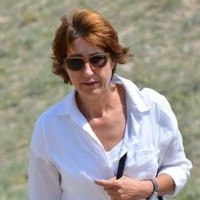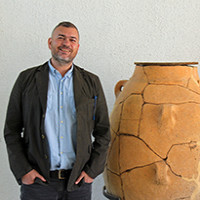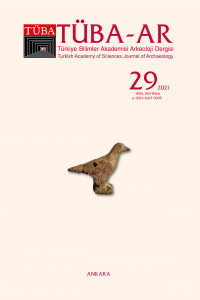Research Article
Issue Editorial Board

After completing his bachelor's and master's degrees at Istanbul University, Department of Prehistory, Karul completed his PhD at the Free University of Berlin in 2000 on a DAAD scholarship. After completing his PhD, Karul worked as an archaeological editor for Atlas Magazine, and in 2002 he joined the Department of Prehistory as an assistant professor; he was promoted to associate professor in 2006 and to professor in 2017. In 2005, Karul received a research fellowship at Harvard University and was a member of the editorial board of EJA (Journal of European Archaeology) between 2013 and 2016. He has been a member of the Colloquium Anatolicum of the Turkish Institute of Ancient Archaeological Sciences since 2014, the Editorial Board of the Journal of Archaeology of the Turkish Academy of Sciences (TÜBA-AR) from 2009-2012 and since 2019, and the Archaeology Editor of the Magma Journal. Karul is also a member of the German Archaeological Institute, the Austrian Archaeological Institute, the ICOMOS Turkish National Committee and President of the Turkish Institute of Ancient Archaeological Sciences. Karul was President of the Istanbul Branch of the Archaeologists' Association between 2007 and 2015. Since 1989, Karul has been involved in prehistoric excavations and surveys in various parts of Anatolia. He was the director of the excavations at Aktopraklık Höyük in Bursa between 2004 and 2009, the scientific advisor of the excavations at Siirt Gusir Höyük between 2010 and 2014, and the director of the excavations at Göbeklitepe and Karahantepe since 2020. Karul, who is continuing the Aktopraklik Höyük research project with the Bursa Archaeological Museum, has been head of the Department of Prehistoric Archaeology at Istanbul University since 2019.

Prof. Dr. Gül Işın graduated from DTCF in 1988 with a BA in Classical Archaeology. She completed her master's thesis in 1991 and studied the ruins of the ancient city of Pednelissos in Pisidia. She received her doctorate from the Institute of Social Sciences at Akdeniz University in 1998 with a thesis titled "Patara Terracottas." She became an Associate Professor in 2004 and a Professor in 2009. Her area of expertise is Hellenistic Period Coroplastics and Sculpture. She has also worked on the Lycian Civilization, Lycian plastics, and burial customs.

He completed his undergraduate, master’s, and doctoral studies in Ankara, at Hacettepe University. He is currently serving as the Chair of the UNESCO 2001 Convention on the Protection of the Underwater Cultural Heritage Monitoring Committee under the Turkish National Commission for UNESCO, as well as the Director of the Institute of Marine Sciences and Technology at Dokuz Eylül University.
He has worked as a visiting researcher and lecturer at Marburg University in Germany, Texas A&M University in the USA, Duke University, and Dumbarton Oaks, a research institute of Harvard University. Özdaş is a member of the advisory board of TINA – Maritime Archaeology Journal and the German journal SKYLLIS. Since 2019, he has also been part of the Editorial Board of the Turkish Academy of Sciences Archaeology Journal.
He has been leading the “Turkey Shipwreck Inventory Project – Blue Heritage,” initiated in 2014 with the support of the Presidency of Strategy and Budget, which is still ongoing. In addition, he directs the Bozukkale, Çamçalık, and Kızlan Ottoman Shipwreck Underwater Excavation Projects. Dr. Özdaş, a certified diving instructor, also holds certifications as a sonar and remotely operated vehicle (ROV) operator.







 Web
Web
VASIF ŞAHOĞLU is Professor at the Department of Archaeology, Program for Protohistory and Near Eastern Archaeology at Ankara University. He is also the current director of Ankara University Mustafa V. Koç Research Center for Maritime Archaeology (ANKÜSAM). His research focuses on the prehistoric and protohistoric archaeology of Anatolia and the Aegean. He conducted excavations at the Bronze Age site of Çeşme - Bağlararası and is currently the director of land and underwater excavations at Liman Tepe in İzmir. Following the passing of Prof. Dr. Hayat Erkanal, he is now also coordinating the Izmir Region Excavations and Research Project (IRERP). He has been publishing on Bronze Age economies, maritime archaeology, Human responses to Natural disasters, long distance travel, contacts and trade issues, burial habits and pottery studies around the Aegean and Anatolia.
Aim & Scope
TÜBA-AR, which started to be published in 2003 with the purpose of documenting, promoting and transferring cultural heritage to future generations, is an international refereed journal includes all tangible and intangible values that can be further increased in number, such as material remains, cultural landscape, decorative arts, natural environment, oral traditions and narratives, performing arts, beliefs, rituals, feasts, events and practices in the memory of society about nature and the universe.
Targeting to be a common ground for all activities under the concept of culture, TÜBA-AR forms the groundwork for studies on basic areas and sub-study areas listed below, without limitation of period and geographical region:
* Archaeology,
* History of art,
* Rural and Urban Architecture,
* Rural and Urban Landscape,
* Cultural Landscape,
* Urban Archeology,
* Industrial Archeology,
* Ethnography,
* Ethnobotanic,
* Geoarchaeology,
* History.
The journal also covers all documentation, inventory and oral history studies on different scales and qualities of cultural heritage such as practices, representations, narratives, information, skills and related tools and cultural spaces that communities, groups and individuals define as part of their cultural heritage. Along with that, TÜBA-AR is open to projects and ideas aimed at protecting, repairing, exhibiting and collecting all the practices identified in the concept of culture and evaluating them as a cultural sector and has also undertaken the function of creating a forum in these fields.
Author Guidelines
PUBLICATION RULES
TÜBA-AR (Turkish Academy of Sciences, Journal of Archaeology) is an international periodical that is published annually by Turkish Academy of Sciences. The Editorial Board appointed by the TUBA Academy Council makes the decisions as to the publication policy, extent and content of the journal (Turkish Academy of Sciences - TÜBA).
SCOPE OF THE JOURNAL
The journal TÜBA-AR principally involves new research, comment, evaluation and methods conducted in the field of archaeology and in archaeology-related fields without any periodic and geographic area restriction. The journal includes newly conducted studies in the field of archaeology, but as a science academy house organ, it is also open to new comments, approaches and analyses in the areas of expertise like cultural heritage management, protection, nature, science and other fields of social science as long as these areas are related to the archaeology.
Excavational working paper-like reports which only offer a material advertisement or lack of new comments and initiatives about excavation and surface research lie beyond the scope of the journal. However, unique findings that break new ground in terms of cultural history can be accepted to the journal as "news."
EDITORIAL PRINCIPLES
The manuscripts may be in Turkish, English, German or French; for Turkish manuscripts an English summary must be added and for the manuscripts that are written in other languages, both a Turkish and an English summary must be provided. The official subtitles must certainly be written in two different languages, one of which is to be Turkish. The keywords and summaries for English and Turkish manuscripts must be offered in Turkish and English; the manuscripts written in other languages must be provided in Turkish and English, as well, apart from the source language of the manuscripts.
The authors are assumed to acknowledge that the manuscripts they write for the journal are authentic and have never been published previously even in another language or have not been submitted for publication elsewhere.
TÜBA-AR is a refereed journal. The editorial board expresses an opinion about the preliminary acceptance of the manuscripts and hand it over to the referees. The manuscripts are referred to at least two referees. The suggestions, criticism and corrections made by the referees are redirected to the authors provided that the referees' names remain anonymous; the authors are obliged to take referees' consult. In case the authors are insistent upon their own manuscripts, the editorial board re-evaluates them.
In accordance with the referees' opinions, the manuscripts cleared for publication by the editorial board are reviewed for their format, spelling rules, references and visual materials; the final assessment is conducted by the editorial coordinator provided there is no crucial defect.
SPELLING RULES
Articles: The articles should be prepared in computer environment. Titles up two lines are allowed; the first line as the 'Title' and the second line as the 'Sub-Title.' Although there is no exact limit on the length of the articles, the average length should not exceed 50000 characters. The articles should be delivered in two phases: first, in a single file, with references and low-resolution illustrations and image subtitles, then in the second phase, once they are cleared for publication, they should be presented in separate files with the text itself, references, high-resolution illustrations and image subtitles. The texts should be prepared in a Microsoft Word processing format. The titles in the texts should be written in bold capitals, the subtitles in capitals, third degree titles in bold, in lower case except for the first letter of the words, and the fourth degree titles in italics, in lower case except for the first letter of the words.
Example:
INTRODUCTION
CULTURAL STAGES
North-Central Anatolia
Ikiztepe
Foreign words and terms found in the texts like "in situ" should be written in italics. Except for the conventional abbreviations like "Before Christ" and "Anno Domini" the abbreviations should not be used and the term should be written in full length. However, frequently-used expressions should first be written in full length with the abbreviations in parentheses, then the abbreviated forms can be used for the rest of the text; for example, General Directorate of Mineral Research and Exploration (MTA). Valid abbreviations:
Abbreviated form of Before Christ: BC and the date, e.g. 475 BC
Abbreviated form of Anno Domini: AD and the date, e.g. AD 456
Before present: BP
Calibrated dates: cal. BC; e.g. cal. 475 BC
Certain period names can be abbreviated; for example, Early Bronze Age, EBA; Late Iron Age (LIA)
The first letter of region names should be in capitals; for example, Central Anatolia, Central America, South-east Anatolia, Central Asia, Near East, etc. Similarly, the first letter of place names, geographic and institutional names is in Capitals ; e.g. Europe, Mediterranean Region, Barbaros Bulvarı, Kızılırmak, Euphrates, Istanbul University, Turkish Historical Society, etc.
Illustrations: The visuals should be in digital format. They should be in high-resolution and the image size should be large. The maximum image number should be 15 in the way that 6-8 images should be selected for print for a 20- page text. No matter what the language of the text is, one of the image subtitles should definitely be in two different languages, one of which is to be Turkish. All the illustrations and intra-textual references should be numbered in the same format. Pictures, images, drawings, etc. should be numbered as Pic.1,2,3 /Fig. 1,2,3... and given at the end of the text. Apart from the illustrations, tables-charts should be numbered as Chart 1,2,3.../Table 1,2,3.... and given at the end of the text.
Every kind of illustrations, whether in horizontal or vertical form, should be suitable for A4 format sizes in order to be used comfortably in the page lay-out.
All the illustrations that may or may not belong to the author should be credited and the ones that require a copyright agreement like googleearth should not be used.
Footnotes: The footnotes should be given as in the examples:
Özgüç 1978, Garstang/Gurney 1959; Forlanini 2007: 151
All the resources presented in the references should make a reference within the text.
Rules for Reference List:
Article:
ALKIM, U.B. 1979.
"İkiztepe Kazısı 1978 Çalışmaları", Belleten XLIII/72: 890-892.
Book Section:
HAMSHERE, J.D. 1987.
"Data Sources in Historical Geography", Historical Geography: Progress and Prospect (Ed. M. Pacione). London: 46-69.
Book:
HAZENBOS, J. 2003.
The Organisation of the Anatolian Local Cults During the 13th Century B.C. Leiden.
BRYER, A/WINFIELD, D. 1985.
Byzantine Monuments and Topography of Pontus. Washington.
Ethical Principles and Publication Policy
Principally, the TÜBA-AR journal covers all recent studies, comments, evaluations, and methods in archaeology, and in adjacent areas related to archaeology, without limitation to any periods or geographic regions. In addition to studies carried out in the field of archaeology, as a publication organ of an academy of science, the journal is open to all professional fields of the social sciences, provided that they are related to archaeology; it has also undertaken the function to create a forum covering recent interpretations, approaches, and analyses developing in these fields.
The journal may feature writings focused on a specific subject as a “file” in order to comprehensively cover new initiatives related to archaeology; and to this end, the Editorial Board decides whether contributions of invited writers are required, or evaluates any requests received in that context. Articles that do not introduce new interpretations and initiatives, but are rather in the form of a preliminary report containing only introductions to materials, including archaeological excavations and surface researches, are out of the scope of the journal. Important findings introducing significant innovations in terms of the cultural history can be accepted as pieces of “news”. When writers send articles to the journal, they are deemed to have agreed and undertaken that the article in question has not been published in any other journal, including its translations into any languages, and that it has not been submitted to any other journal for publication, including its translations.
Price Policy
Makale gönderim/süreç işletimi ücretsiz olarak sürdürülmektedir.
Publisher
Vedat Dalokay Caddesi No: 112 Çankaya 06670 ANKARA
TÜBA-AR Turkish Academy of Sciences Journal of Archaeology (TÜBA-AR) does not officially endorse the views expressed in the articles published in the journal, nor does it guarantee any product or service advertisements that may appear in the print or online versions. The scientific and legal responsibility for the published articles belongs solely to the authors.
Images, figures, tables, and other materials submitted with manuscripts must be original. If previously published, written permission from the copyright holder must be provided for reproduction in both print and online versions. Authors retain the copyright of their works; however, upon publication in the journal, the economic rights and rights of public communication -including adaptation, reproduction, representation, printing, publishing, and distribution rights- are transferred to the Turkish Academy of Sciences (TÜBA), the publisher of the journal. Copyright of all published content (text and visual materials) belongs to the journal in terms of usage and distribution. No payment is made to the authors under the name of copyright or any other title, and no article processing charges are requested. However, the cost of reprints, if requested, is the responsibility of the authors.
In order to promote global open access to scientific knowledge and research, TÜBA allows all content published online (unless otherwise stated) to be freely used by readers, researchers, and institutions. Such use (including linking, downloading, distribution, printing, copying, or reproduction in any medium) is permitted under the Creative Commons Attribution-NonCommercial-NoDerivatives 4.0 International (CC BY-NC-ND 4.0) License, provided that the original work is properly cited, not modified, and not used for commercial purposes. For permissions regarding commercial use or licensing exceptions, please contact the journal.
